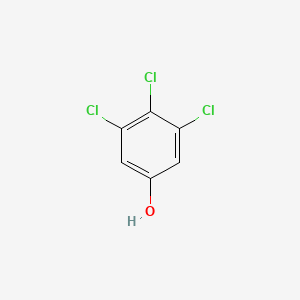D0695 | 3,4,5-trichlorophenol
| Toxicity | Dose | Time | Species | Model | Method | Action | Positive criterion | Reference |
|---|---|---|---|---|---|---|---|---|
| MEMBRANE POTENTIAL | 3.80±1.74 | human | qHTS-HepG2 | MMP assay | decrease | IC50 | 163 | |
| MEMBRANE POTENTIAL | 5.01 | human | HepG2 | MMP assay | decrease | IC50 | 163 | |
| MEMBRANE POTENTIAL | 33.82±17.20 | rat | hepatocytes | MMP assay | decrease | IC50 | 163 | |
| Pictogram | Signal | Statements | Precautionary Statement Codes |
|---|---|---|---|
   |
Danger |
Aggregated GHS information provided by 42 companies from 3 notifications to the ECHA C&L Inventory. Each notification may be associated with multiple companies. Reported as not meeting GHS hazard criteria by 1 of 42 companies. For more detailed information, please visit ECHA C&L website Of the 2 notification(s) provided by 41 of 42 companies with hazard statement code(s): H302+H312+H332 (92.68%): Harmful if swallowed, in contact with skin or if inhaled [Warning Acute toxicity, oral acute toxicity, dermal acute toxicity, inhalation] H302 (100%): Harmful if swallowed [Warning Acute toxicity, oral] H312 (100%): Harmful in contact with skin [Warning Acute toxicity, dermal] H315 (100%): Causes skin irritation [Warning Skin corrosion/irritation] H318 (92.68%): Causes serious eye damage [Danger Serious eye damage/eye irritation] H332 (100%): Harmful if inhaled [Warning Acute toxicity, inhalation] H335 (100%): May cause respiratory irritation [Warning Specific target organ toxicity, single exposure Respiratory tract irritation] H400 (92.68%): Very toxic to aquatic life [Warning Hazardous to the aquatic environment, acute hazard] H410 (92.68%): Very toxic to aquatic life with long lasting effects [Warning Hazardous to the aquatic environment, long-term hazard] Information may vary between notifications depending on impurities, additives, and other factors. The percentage value in parenthesis indicates the notified classification ratio from companies that provide hazard codes. Only hazard codes with percentage values above 10% are shown. |
P261, P264, P270, P271, P273, P280, P301+P312, P302+P352, P304+P312, P304+P340, P305+P351+P338, P310, P312, P321, P322, P330, P332+P313, P362, P363, P391, P403+P233, P405, and P501; (The corresponding statement to each P-code can be found at the GHS Classification page.) |
| 2JF54EGE7O | 3,4,5-TRICHLOROPHENOL | 3,4,5-Trichlorophenol 10 microg/mL in Acetonitrile |
| 3,4,5-Trichlorophenol 10 microg/mL in Isooctane | 3,4,5-Trichlorophenol 100 microg/mL in Acetonitrile | 3,4,5-trichlorphenol |
| 3,4,5-tris(chloranyl)phenol | 3,5-Trichlorophenol | 609-19-8 |
| A832955 | AK135672 | AKOS006275453 |
| AX8081521 | BBV-38275671 | BDBM91350 |
| CAS-609-19-8 | CCRIS 6110 | CHEMBL1484480 |
| CTK5B2439 | DS-5129 | DSSTox_CID_6212 |
| DSSTox_GSID_26212 | DSSTox_RID_78061 | DTXSID4026212 |
| EINECS 210-183-0 | FCH839650 | FT-0648040 |
| GBNHEBQXJVDXSW-UHFFFAOYSA- | GBNHEBQXJVDXSW-UHFFFAOYSA-N | HMS3039M04 |
| HSDB 6292 | InChI=1/C6H3Cl3O/c7-4-1-3(10)2-5(8)6(4)9/h1-2,10H; | KS-000002GE |
| LS-1451 | MLS002302993 | NCGC00091866-01 |
| NCGC00091866-02 | NCGC00257742-01 | NSC 243667 |
| NSC-243667 | NSC243667 | Phenol, 3,4,5-trichloro- |
| Phenol,3,4,5-trichloro- | PubChem12939 | Q27254825 |
| SC-86364 | SCHEMBL330705 | SMR001307309 |
| TR-020995 | Tox21_200188 | UNII-2JF54EGE7O |
| UNII-8Z4R9J59DL component GBNHEBQXJVDXSW-UHFFFAOYSA-N | WLN: QR CG DG EG | ZINC1764636 |
| cid_11859 |
| CAS Number | 609-19-8 |
| PubChem Compound | 11859 |

